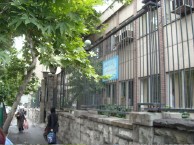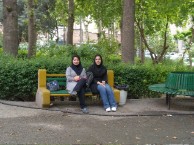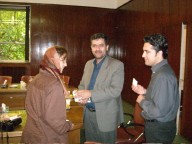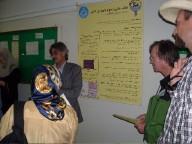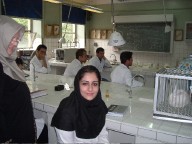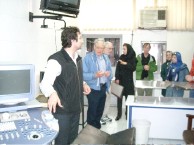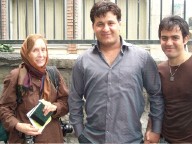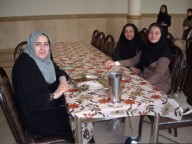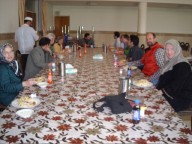Report to Chancellor Vanderhoef
Veterinary School Visit, University of Tehran, Iran
Linda S Clark, DVM, MA
Iran
Land of terrorists.
Arch enemies of the United States.
Or Not.
I recently completed a two week visit (April 25 - May 10, 2009) to Iran
under the auspices of Neighbors East and West which combined my
interests in veterinary medicine, people to people peace mongering and
foreign travel. Neighbors East and West is an organization dedicated to
lessening international tensions and promoting peace through sister
city and grass-roots people-to-people contacts. In the past they
sponsored trips to the former Soviet Union and Cuba.
Prior to leaving I talked with UC Davis Chancellor Vanderhoef,
Assistant Vice Provost Robert Kerr and Veterinary School Dean Bennie
Osburn about furthering connections between the veterinary schools at
UC Davis and those at the Universities of Tehran and Shiraz. I also
talked with three Iranian veterinarians currently enrolled in the MPVM
(Master of Preventative Veterinary Medicine) program at UC Davis. I
made contact with20two veterinarians in Iran, Dr. Vadood Razavilar of
the University of Tehran who completed his MPVM and PhD degrees at UCD
and Dr. Sadar Jafari who also completed an MPVM at UCD. Both men
arranged with their respective deans for me and several members of my
group to tour their respective veterinary schools. Unfortunately the
two days we had in Shiraz were on the weekend which precluded visiting
the school there. Most of the following comments will, therefore, refer
to the veterinary school at the University of Tehran although I am
confident that much I have to say applies to both schools and likely
the other veterinary schools in Iran.
There are five government veterinary schools in Iran and a number of
private ones with the government ones being considered more
prestigious. Students completing high school take a nation wide college
entrance exam. In 2001 something on the order of 1.5 million students
took this exam. Their score on this exam determines their choice of
university and also which majors are open to them. The veterinary
school curriculum is a six year program resulting in a DVM (Doctor of
Veterinary Medicine) degree. Besides courses relating to veterinary
medicine students are also required to take courses in Farsi (Persian
language), English, computer proficiency, and Islamic studies. While
the emphasis is on food animal technology (cattle, sheep, goats,
camels, poultry, fish and food safety) equine and small animal medicine
is also taught. There are no post-DVM exams comparable to national and
st ate board exams required of graduating veterinary students in the
United States.
The University of Tehran was established 100 years ago by Reza Shah.
The School of Veterinary Medicine there is 70 years old. After the
1978-79 Islamic revolution public Friday prayer was instituted by the
government. The University of Tehran campus is one of many places in
Iran where these prayers take place. At present there are about 300
undergraduate students and 100 post-graduate students in the veterinary
school. At least 50% of the students are female. As in this country
when I graduated in 1980, job opportunities for women in equine and
food animal medicine and surgery are limited to non-existent. Many
women veterinarians look for positions with veterinary pharmacies or in
academia.
Ten of our group of 24 people elected to tour the veterinary school.
The group included myself, a retired small animal emergency
veterinarian, a retired MD internal medicine specialist, a retired
nurse, a Montana cowboy, a practicing environmental attorney, a retired
college physics professor and several other retired teachers. All of us
have an interest in establishing people to people contacts in other
countries, especially those countries considered as something other
than allies by our government and/or theirs, in the interest of
peaceful co-operation between nations. We are also interested in
facilitating international exchanges of scientific ideas and
information.
The undergraduate teaching facilities and the small animal teaching
hospital are in the city of Tehran A fascinating mixture of old
and new, Tehran itself is one of the largest cities in the world with a
population of fifteen plus million. The food animal facilities are on
the outskirts of the city. Time constraints did not allow us to visit
them.
Upon arrival we were ushered into a conference room and presented with
coffee and snacks while we discussed the purpose of our visit with Dr.
Akhoondzadeh, advisor to the Dean of the Faculty of Veterinary Medicine
on International Relations, Dr. Razavilar, Professor of Food
Safety, Dr. Alireza Bahonar, Department of Epidemiology, Dr. Molazem,
veterinary radiologist, Dr. Akbarein, veterinary epidemiologist, and
Dr. Omid Nekouie, veterinary epidemiology.
We were then given a tour of several of the teaching
laboratories. I was reminded of the facilities in Haring Hall when I
was a student in the late 1970’s, that is, old but perfectly
adequate for the task at hand even if not “state of the
art“ as current students at UC Davis enjoy. In a food
microbiology lab we observed students plating Petrie dishes with
E. coli. We observed one of the food hygiene labs where milk is tested.
All milk in Iran, except that produced locally in small villages, is
pasteurized. Food safety issues are taken seriously in Iran.
We also visited an anesthesia lab where students were using rabbits to
learn about a variety of anesthetic drugs including ether, thiopental,
ketamine, and zylazine, as well as intubation tech niques. As in
the United States, Iranian veterinary schools contend with animal
rights activists.
After viewing a variety of laboratories we crossed a wide busy street
to the small animal teaching hospital. Again the facilities, while
clearly dated, seemed both adequate and clean to me. No statistics are
kept regarding numbers of pets owned in Iran. Pets include dogs, cats,
hamsters, tropical fish, lizards, snakes, and the Persian squirrel.
Dogs, but not other canines, are considered unclean in Islam and are
technically forbidden under Islamic law. Not withstanding, we not only
saw many dogs being used for herding sheep and goats in the countryside
(presumably a legal usage) but also talked with many people who keep
dogs as pets. Like pet owners everywhere, dog owners in Iran love their
dogs. City dogs must be kept inside. It is illegal to walk them on the
streets because of the risk of contaminating people. Humane euthanasia
is permitted under Islamic law. We observed several canine and feline
patients interacting with their concerned owners, and being examined by
students and hospital clinicians. We also inspected the hospital
surgical and radiographic facilities.
Upon returning to the main portion of the school we saw a small
but fascinating museum relating to animals and veterinary medicine
before going into the veterinary student cafeteria where we were served
a delicious lunch and treated to more conversation with our hosts as
well as engaging with several of the undergraduate students. In
the words of one of my fellow travelers, “I enjoyed the
luncheon, and enjoyed the informal conversation that went with
it.”
To quote another fellow traveler, “I was certainly impressed with
how gracious and welcoming all our hosts were at the vet school.
Certainly they treated us like honored guests. They opened the entire
school to us and showed us as much as they could.” This was
our third day in Iran. We soon came to realize the warmth and
graciousness, the hospitality, the desire to interact with Americans,
the concern that we enjoy as fully as possible our visit to Iran was
not unique to veterinary school personnel. Everywhere we went in
Iran we were treated the same, often being told “we love
Americans.” Iranians have no trouble distinguishing between
“official” government policies, ours and theirs, and the
thoughts and feelings of ordinary people.
The purpose and significance of the visit to the veterinary school was
not, of course, to enjoy Iranian hospitality, as enjoyable as that was
for us. Some additional comments from the group support the
primary significance, that of facilitating the exchange of ideas and
people between the US and Iran. “For me the opportunity to
engage with the Iranian scientific community (in a very small scope)
was one of the most positive aspects of my visit to Iran.”
“I was very much impressed with the apparent level of research
which they were performing.” “It felt quite comfortable to
me that the grad students and professors talked to us about how science
crosses political borders and how they very much want more exchanges
with their counterparts in other parts of the world.” “I
was interested to find out that the areas of animal epidemiology and
food safety were combined together as an area of research; perhaps that
is common, but it surprised me.” “I was oblivious to the
topic of infectious diseases that can occur in human beings and the
rest of the animal world; veterinary science is so much more than
keeping pet dogs and cats healthy and happy!” I had some good
(although short) conversations with a couple of the faculty on
brucellosis. That is of interest in Montana, since it is endemic in
Bison and Elk, and some controversy exists over the extent to which
that can affect the cattle industry. It was interesting to learn that
the Iranian approach to the disease is to manage it, rather than try to
eradicate it - at least that was my take on the responses I received.
Almost from the beginning of our initial discussion in the conference
room it was abundantly clear to me that Iranian veterinarians, from
students to senior faculty are eager to engage in new contacts, as well
as build on already existing contacts with their counterparts in
America, and in particular in Davis. Students want to do externships.
They also want to come for the MPVM program and to participate in PhD
and post-doctoral programs. (There are Iranian students participating i
n these programs at Davis, but not nearly as many as would like to do
so.) Faculty members want to come as visiting professors and for
sabbaticals. Many faculty members asked that I put them in touch with
their respective counterparts at the veterinary school at UC Davis so
they may begin an exchange of ideas and discussions of common areas of
research and interest. I’ve been assured that UC Davis veterinary
students would be welcomed to do externships or other types of studies
at the veterinary school of the University of Tehran. Since English is
widely spoken they do not envision language differences as presenting
problems for Davis students. I believe, had I had the authority
to do so, those with the authority to do so for the veterinary school
in Tehran would have signed almost any accords or memorandums of
understanding necessary to facilitate these types of exchanges on the
spot. They were, I think, disappointed to learn I had no such official
capacity.
I did come back having promised almost everyone I talked with
there that I would do everything in my limited power to facilitate such
interactions.
Here are some thoughts regarding what I can do.
A. I am putting together a power point presentation of my
trip to Iran. I would like to do a presentation for interested
veterinary school faculty and students stressing the benefits of such exchanges.
B. I also want to talk with individual faculty encouraging
them to engage in contacts with their counterparts in Tehran.
C. I intend to send letters to the CVMA and JAVMA
encouraging practitioners to do likewise. I have talked briefly with
Dr. Saud Joseph, former chair of the Middle
East/South Asia department and will follow up with her in the
future.
Indeed, that department’s brochure on
Iranian studies refers to “UC Davis’ vision of
internationalizing the campus with
academic partnerships, exchange of students
and scholars, and cultural cooperation with Iran.”
On the flight home I was fortunate to be seated beside Dr. David Bunn,
project manager at the UC Davis School of Veterinary Medicine Wildlife
Health Center. He indicated part of his job is to facilitate exchanges
between veterinarians at UC Davis and several African countries and
that he is looking to expand those exchanges to other countries. I am
open to suggestions as to what more I might do as a private individual
or perhaps even as an “official” representative of UC
Davis. To again quote fellow travelers, “What I am firmly
convinced of is the world‘s crying need for more healthy,
friendly contacts among young people in every country!” “I
would expect that some kind of exchange arrangement would be good in
many ways, since international tensions often can be reduced through
academic exchanges, and both sides would profit and learn from the
other.”
Postscript: I forwarded a copy or this to the people at the veterinary school at the University of Tehran
hoping to give them the opportunity to add whatever comments they wis hed. Unfortunately pre- and
more particularly post- election turmoil in Iran precludes my chances of receiving such in a timely manner.
